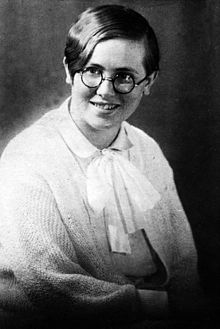Judith Auer
Judith Auer (born Vallentin ; born September 19, 1905 in Zurich , † October 27, 1944 in Berlin-Plötzensee ) was a resistance fighter against National Socialism .
Life
Judith Auer's parents were the writer Franz Vallentin and his wife Margaret, née Hoffmeister. Her cousin Maxim Vallentin later went to the theater. The family lived in Berlin from 1907. Judith and her sister Ruth, later Ruth Cidor-Citroën , first attended a private school, then the Lyceum and graduated from high school. After the early death of their parents in 1917, they were brought up by a wealthy Jewish family. Two other, younger twin siblings, Andreas and Gabriele, were given to a children's home and later to foster parents. Judith Vallentin began studying music in line with her career aspirations to become a pianist , which she soon had to abandon for financial reasons.
In 1924 she joined the Communist Youth Association (KJVD) as a student and moved to Berlin in 1925. Here she married the KPD functionary Erich Auer in 1926 (divorced in 1939). In 1927 she joined the KPD. In 1928 she went to Moscow with her husband and worked there in the office of the Communist International .
Their daughter Ruth was born in 1929. In order to earn money, Auer learned typewriter and shorthand . She took a job at an institution of the Communist Party of Germany (KPD) and joined the agitprop group " Das Rote Sprachrohr ", which was led by her cousin Maxim Vallentin. From 1933 she took part in anti-fascist awareness - raising work and distributed leaflets against rearmament and the threat of war.
In 1937 she was at the AEG in Kabelwerk Upper Spree in Berlin work; initially again as a stenographer, then from 1939 as a buyer. Auer got in touch with the resistance group around the welder Fritz Plön , who in turn had contact with the resistance group around Anton Saefkow , Franz Jacob , Bernhard Bästlein and Karl Klodt .
Auer managed the finances of her resistance group and used business trips for courier services, in particular to contact Theodor Neubauer and Magnus Poser in Thuringia . After his escape from Hamburg, she hid Franz Jacob for several months in her apartment at Gehrenweg 63 in Berlin-Bohnsdorf .
On July 7, 1944, Judith Auer was arrested at her workplace. She was sentenced to death by the People's Court together with Bruno Hämmerling and Franz Schmidt and was guillotined on October 27, 1944 in Berlin-Plötzensee , holding a photo of her daughter in her hand. When asked in court whether she had not thought of her daughter, she replied: "Precisely because I think of my daughter, I am and will remain a communist". In her files it is noted by the head teacher of the women's prison in Barnimstrasse: “Delicate by nature, at the same time brave and mature in rare proportions. Full of goodness. Faithful. Brave and mastered to the end ”.
The daughter Ruth was hidden in a summer house by Judith's sister Gabriele in the eastern part of Berlin, Ruth, Gabriele and the brother Lucas survived the Holocaust as " half-Jews " . Gabriele's twin brother Andreas died when he fled to Russia as a communist, trapped in a Soviet labor camp of exhaustion. Judith's sister Ruth, after whom Judith had named her daughter, was also able to escape with her family, taking an adventurous detour via Paris to Switzerland. She died in Israel in February 2002.
Honors

In the GDR she was honored by naming several streets (e.g. in Berlin-Fennpfuhl , Jena-Lobeda ) and public institutions, including a children's home in Barth.
literature
- Antje Dertinger : Hero's daughters . Verlag JHW Dietz Nachf. Bonn , 1997, ISBN 3-8012-0253-4 , chap. "And then I imagined: She is still alive, but she is far away" Ruth Hrotzschansky - a child of the communist resistance, p. 34-52 .
- Annette Neumann, Susanne Reveles, Bärbel Schindler-Saefkow: Berlin workers' resistance 1942–1945. "Away with Hitler - end the war!" The Saefkow-Jacob-Bästlein-Organization. Berlin Association of Those Persecuted by the Nazi Regime - Bund der Antifaschisten und Antifaschistinnen eV, Berlin 2009, p. 44
- Ursel Hochmuth : Illegal KPD and movement “Free Germany” in Berlin and Brandenburg 1942–1945. Biographies and testimonials from the resistance organization around Saefkow, Jacob and Bästlein. Writings from the German Resistance Memorial Center, Series A, Vol. 4; Berlin 1998 p. 110
- Ruth and Günter Hortzschansky : Judith Auer (1905–1944). May all pain not have been in vain . Trafo-Verlag, Berlin, 2nd ext. Edition 2017, ISBN 978-3-86464-116-9 .
- Luise Kraushaar : German resistance fighters 1933 to 1945. Berlin 1970 Volume 1, p. 59ff
Individual evidence
- ↑ Ruth Cidor-Citroën: From the Bauhaus to Jerusalem. Stages of a Jewish life in the 20th century . Metropol Verlag, Berlin 2004, p. 10, ISBN 978-3-936411-39-3
- ↑ a b Cristina Fischer: Von Judiths Weg - A moving biography of the Berlin anti-fascist Judith Auer (1905–1944) . In: Ruth & Günter Hortzschansky: Judith Auer (1905–1944). "May everything painful not have been in vain ..." . Trafo Verlag Berlin, July 1, 2005. Last accessed November 27, 2018.
- ↑ Treptow-Köpenick Memorial Sites (as of 2016) , p. 79.
- ↑ Ruth Cidor-Citroën: From the Bauhaus to Jerusalem . Pp. 91, 194, 212.
Web links
- Literature by and about Judith Auer in the catalog of the German National Library
- Short biography on the BdA Köpenick website
- Short biography of the German Resistance Memorial Center
| personal data | |
|---|---|
| SURNAME | Auer, Judith |
| ALTERNATIVE NAMES | Vallentin, Judith |
| BRIEF DESCRIPTION | German resistance fighter against National Socialism |
| DATE OF BIRTH | September 19, 1905 |
| PLACE OF BIRTH | Zurich |
| DATE OF DEATH | October 27, 1944 |
| Place of death | Berlin-Plötzensee |
